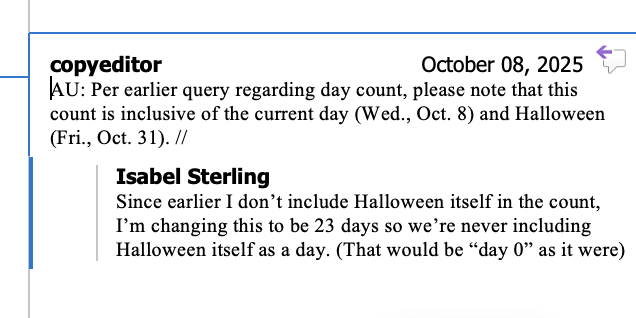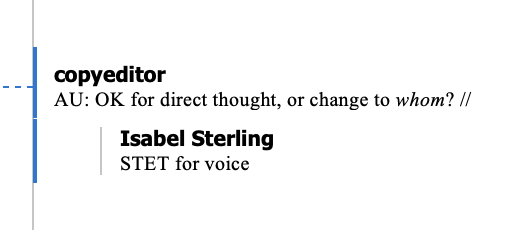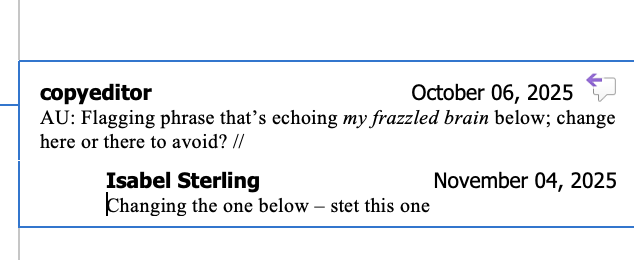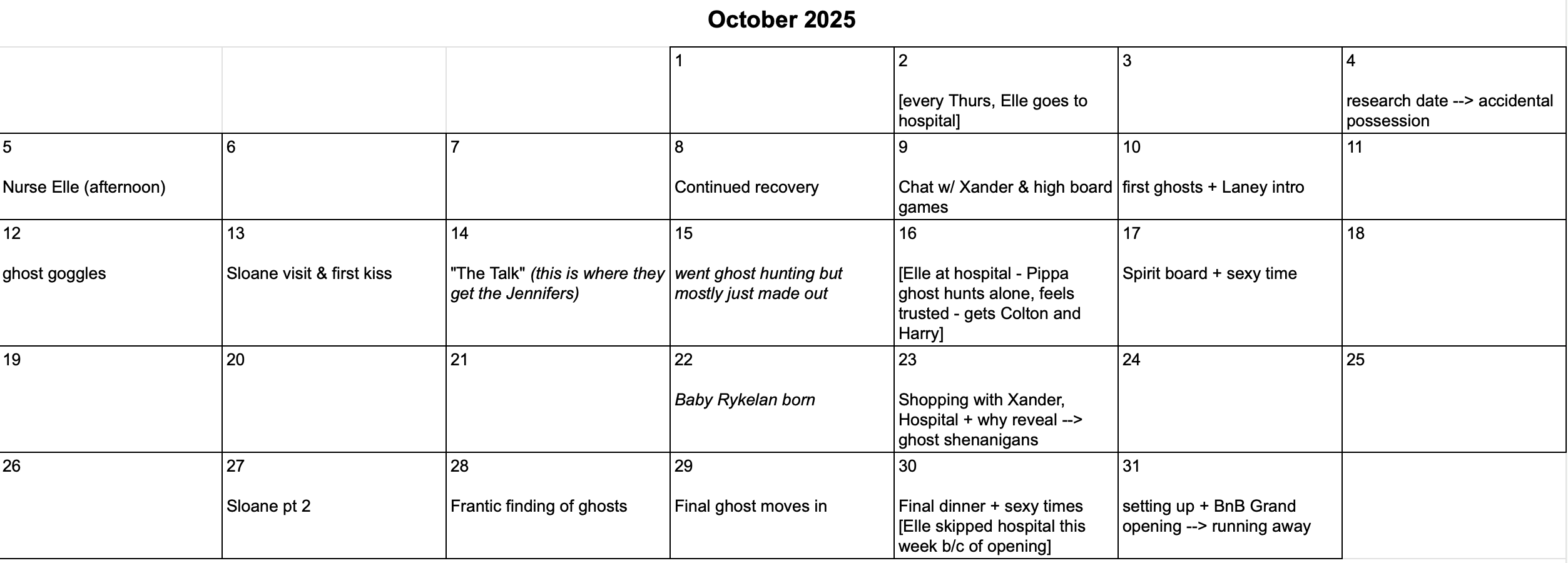How to Make Copyedits Suck Less
Nov 17, 2025Copyedits! CEs! The least favorite part of the editing process for may authors, this is the stage where a Grammar Nerd descends upon your book with a digital red pen and point out all your mistakes.
It's also the part where many authors decide they hate their book actually, and can they set the whole thing on fire and never look at it again?
Here's the good news: copyedits don't have to be a nightmare.
But before I share my process for making CEs a low-key, chill part of the publishing process, a quick reminder:
The January class of The Confident Author Academy is enrolling now!
At the time of writing this post, we have 9 incredible authors signed up to spend six months together building better writing lives, more sustainable schedules, and a more confident career. We have:
- 2 agented writers working toward their first book deals
- 2 debuts with first books out in 2026
- 5 authors with 2+ books out (one of whom is about to release her 10th next year!)
These authors write across MG, YA, and adult. There's all sorts of flavors of fantasy, romance, gothic, mystery, and contemporary stories among them. I also tend to attract a lot of queer and neurodivergent writers, too.
We are going to have an amazing six months together, and I would love for you to join us.
CLICK HERE to learn more and submit your application.
Okay, let's talk about copyedits!
I recently received CEs for With All My Haunted Heart, and as I worked on them, I realized that my relationship with copyedits is much different from most other authors.
In fact, I actually like this stage of the process. (I know. I'm a nerd. I can't help it.)
So, let's talk about how to make them easier -- and quicker!
Your Copyedit Mindset
Before we dive in too deep, I have a couple of important caveats:
- Everyone's process is a bit different -- if anything I share here doesn't work for you, toss it. You're not wrong for doing things differently!
- This process works best when you had enough time at the line editing stage to do a close read through and really got the book where you want it to be. That isn't always the case for every book, especially if you end up on tight editing timelines. If you were still doing a lot of heavy lifting during line edits, you probably will want to do a close read during copy edits (more on that in a bit)
- I'm also writing this from the assumption that you had an average or better copyeditor (which has been my experience for 4 novels + a novella at this point). I have heard horror stories of copyeditors who go in and basically try to rewrite 80% of the sentences into their own voice. While this is rare, it does happen. Your process of reviewing that kind of copy edit is going to be a bit different than what's laid out here.
Okay, caveats made, let's dive in!
Before you dive into the copyedited manuscript, it's important to consider what mindset you're bringing to the process. Here are some of the beliefs that can help you get through this process with your love of your story intact.
The copyeditor is on my team.
It's their job to point out everything that might throw readers out of the book.
Your copyeditor realizes that the teens in your YA novel are unlikely to properly use "whom" in their dialogue. It's still their JOB to point out when the grammar rules say it should be whom instead of who. Some CEs will change it in the text. Some will flag it in a comment. Either way, it's their job to point it out. It's YOUR job to decide whether you want to follow that rule or not. (More about how to use STET later.)
This "we're a team" mindset also puts me in a a place where I can have a dialogue with my team in the comments. Here's an example from this recent pass:

In cases like this, I like providing my preference alongside an accommodation for potential house style concerns (if I'm genuinely okay with the second option.)
Here's another one where we were figuring out some timeline stuff:

And some more timeline stuff (this leads to one of my "do different next time" notes later!):

I trust the previous version of me who did a close read of this during line edits.
Again, as I mentioned above, not everyone has the chance to do a deep read at the line editing stage, so if this doesn't apply to you, that's okay.
In the case of With All My Haunted Heart, I was had ample time during the line editing pass (which was fairly minor) to make all of my editor's requested changes and then go back through and do things like search for repeated words, remove crutch phrases, and also have my computer's accessibility function read the entire manuscript aloud to me.
I'd already caught a lot of the small errors and adjust the language to where I wanted it. I loved the story.
So when it came time to do copyedits, I was willing to trust that the July version of me who finished that deep read at line edits was good at their job. I didn't need to triple check their work.
This allowed me to complete all of my copy edits in a little over five hours, split across four days. Which was super helpful, since I'm on deadline for the sequel and was still able to make forward progress on that first draft during that time.
For those of you who didn't get a chance to do your close read through at the line edit stage (or you were still making substantial changes), you probably will want to read through the copyedited manuscript once you've finished going through them. That doesn't mean you don't trust yourself. You just didn't get a chance to do that step.
I've been there. When I was working on my 2020 release, This Coven Won't Break, I was still making pretty major changes during line edits (and some during copyedits, too!) so I'm pretty sure I did my close read at the CE stage. (As far as I can remember from six years ago 😅.)
Small errors will not break this book. There is a point of diminishing return.
This will come down to personal preference in a lot of ways, but for me, I do not find it useful to force myself to do an extra deep read on the off chance that the copyeditor missed a comma somewhere.
I genuinely do not think a couple of typos will make any difference in the overall reception of a book.
This isn't to say I'm careless with my work or that I don't have high standards for the stories I tell. I care deeply that my books resonate with readers and make an impact on the world.
I just don't think spending hours and hours hunting for typos is going to make any noticeable difference on that impact. If any at all.
Is it annoying when readers find the one or two typos that slipped in? Sure.
Does it break a book? No. Not even a little. At least for me -- both as a writer and a reader.
I'd much rather dedicate those extra 5-20 hours to writing my next book than hunting for small mistakes.
My Tactical Process
Okay, let's get to the tactical advice! Here's how I approach CEs:
Step 1: Address all the easy stuff first
I use the "next comment" and "next tracked change" buttons in Word to jump through the manuscript to see what's been marked up.
Any in-text changes I disagree with (and have a quick solution), I'll either STET or make the quick change in text. If the change is more than a few words, I'll add a comment bubble with "***come back and check this later" so I can simply search the "***" and jump right to all those comments.
If the CE had a question or a change that requires me to really consider the solution (especially if it requires me to reference another area of the book), I add a comment that says, you guessed it, "***come back to this."
This allows me to buzz through most of the manuscript and get the bulk of the changes sorted and assess how much time I have left to deal with the bigger items.
Step 2: Use the find function to search for all the "***" notes and address those
Once all the easy stuff is out of the way, it's time to do the work that actually requires me to think at a deeper level.
Sure, you could just answer each thing in order, but separating the super easy stuff from the "hmm, I need to cross reference these chapters and compare against my timeline" stuff, is so much easier on my brain. It feels like I'm doing l less "task switching" in my head when I separate these out.
And because I use the triple * on all of those notes, it's super easy to jump around and catch them all.
(Note: if your manuscript uses that mark for something else, pick a different special character that isn't used in the document.)
Once I've made the fix, I delete that comment bubble with my note to self.
Step 3: Final check of all the comments
This one is mostly an accommodation for my anxiety, but I like to do a final check of all the margin comments to make sure I addressed everything. I want to make sure I've responded to every "is this okay?" query from the CE with a yes or a no.
I also like to triple check that I've actually deleted all of my "***check this later" notes.
By using the "next comment" button, I don't have to scroll through every page. I can just check each individual comment.
And since I don't do a full read through at this stage (unless I didn't get a chance to at line edits), that's it! It goes back to my editor.
STET with Abandon (Mostly)
No post about copyedits could be complete without a discussion of STET.
STET comes from latin "let it stand." Simply put, it means "Hey, I don't like this change. Put it back exactly like I had it originally." But, like, less sassy.
When using STET, remember that your CE is on your team. Their job is to point out the things that would make something "technically" more correct. It's YOUR job to preserve your voice and your characters' voices.
You don't need to go into great detail about why you want to STET something if it's voice related. My most common comment is simply "STET for voice"
That's it. You don't have to explain that your character is not the kind of person who would use "whom" correctly. "STET for voice" is all you need.

Here's another example. Note that I didn't change their in-line changes (in blue). I just left the STET comment. The production team will put it back how it was.
Is their version more straightforward and probably more technically correct? Sure. But the rhythm of their version in the context of what came before didn't feel right. So we STET!

Another way I use STET (that I'm not sure it technically required, but I like it), is when the CE flags an echoed word or phrase. I'll usually make a note like "changing the next one - STET this one." I like this because it lets them know right away that I've addressed their comment and increases clarity of what I want to change vs keep.

Now, personally, I don't get too fussy about things like changing "blonde" to "blond" or "grey" to "gray." Do I have preferences? Yes. Do I care enough to push back against house style for those things? No.
Your mileage may vary.
A Helpful Tool
Looking at a document that's been marked up to hell and back can become unwieldy. If you and your CE have both tweaked a sentence in-text, it can be challenge to read it back smoothly to make sure it sounds the way you want it to.
And sometimes... it's hard to tell at a glance if your CE added or removed an apostrophe. (Though, maybe that's just my old eyes.)
It can also be hard to spot where you've accidentally added an extra period when making changes.
The best solution for this is being able to toggle between "all markup" (which is how it'll likely open and will be the main thing you look at while doing CEs), "simple markup" (great for clarifying what change the CE made or what you've changed things to), and "original document" (if you need to get clear on what you wrote initially if the in-text changes make it hard to parse out your original sentence).
This is where those tools exist on my version of Word (on my Mac) - in there "Review" tab:


Here's what that looks like in practice. This first one is "All Markup":

The CE had highlighted "past my lips" since that was a phrase I used too many times that chapter.
Then to make sure I liked my new version, I toggled over to "Simple Markup" to get a clean read. (The red lines on the side indicate there are hidden changes in those locations.)

This process also saved me from an embarrassing moment...
There's a reoccurring line in the book -- something shitty my MC Pippa's mom said to her. This is what it looked like in All Markup:

It looks more obvious here because it's larger, but when it was in smaller font, I thought my CE had added that apostrophe.
And I was annoyed.
Because more than one Erikson is Eriksons. Not Erikson's!
I added a comment saying I was pretty sure it should be Eriksons and said to STET.
But the CE had been so good throughout. This felt like a really weird mistake for them to make. THANKFULLY, I thought to switch over to "Simple Markup" to double check.

And yup. I was the ding dong who had included an unneeded apostrophe, not my CE. 😅
I am so glad I caught my mistake before sending it back. Sorry for doubting you, anonymous copyeditor!
Things I'll Adjust for my Next Book
From this round of CEs, the thing that I think both my CE and I had to spend the most brainpower really figuring out was the timeline of the book.
But! I actually kept a really detailed calendar of exactly what day each scene happens in the book. (Like spoilers included - view closely at your own risk!)

I wish I had thought to send a PDF of that calendar to my editor when I turned in line edits with a specific note that she could pass it along to the CE. Had I done that, the CE wouldn't have had to cobble together what they thought my intention was. Instead, they could use the calendar to point out where I was either violating my own calendar or was unclear in the text and might throw off the reader.
For my next book, I will send my calendar along. This is something I do for my writing process anyway, so it won't add any extra work to my plate while it will (in theory) make the CE's life easier.
Though I will probably need to put a little more detail in it since those are simple the titles of the scenes in my Scrivener file and may not mean much to someone else...
Final Thoughts
I hope this peek behind the curtain of my process for reviewing a copyedited manuscript was helpful! If you have additional questions about tackling your CEs (or another part of the editorial process!), leave a comment below and let me know! If there are enough questions, I'm happy to do a part 2. I love getting into the weeds like this. It makes the nerdy part of me very happy.
Until next time, happy writing!
-Isabel
PS - The January class of The Confident Author Academy is enrolling now! Get your application in before enrollment closes on Nov 22nd. Sign up now!
PPS - Don't miss a single issue of Real Talk for Writers. CLICK HERE to sign up for the Real Talk newsletter. You'll receive an email every other Monday morning with the newest issue plus notifications about upcoming workshops.

